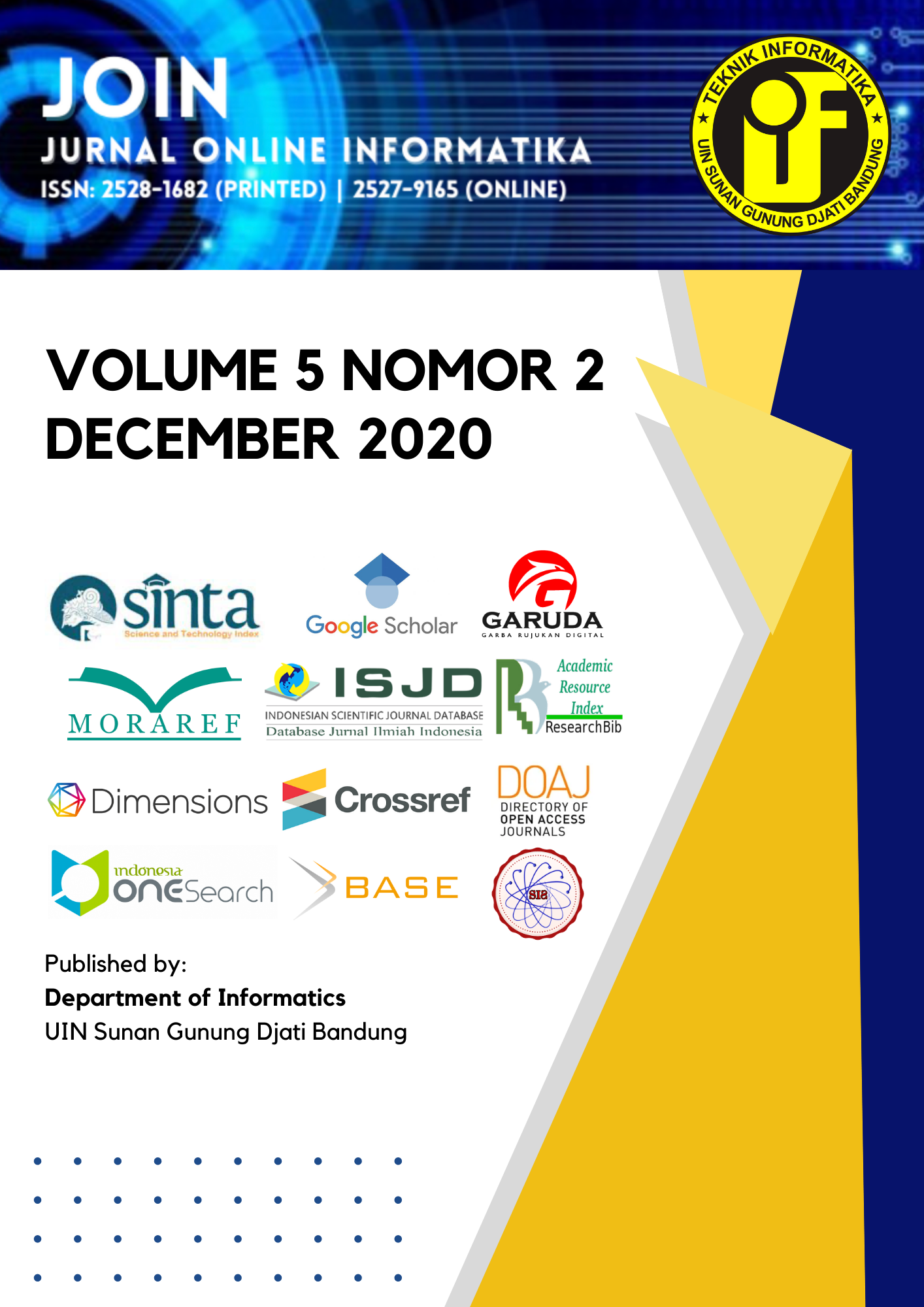Geographic Information Systems for Crime Prone Areas Clustering
DOI:
https://doi.org/10.15575/join.v5i2.599Keywords:
Crime, Geographic Information Systems, Clustering, K-MeansAbstract
References
BPS, “Kabupaten Purwakarta dalam Angka 2019,†Badan Pus. Stat. Kabupaten Purwakarta, 2019.
F. D. Yuliansyah, “Sistem Informasi Geografis Untuk Klasifikasi Daerah Rawan Kriminalitas Menggunakan Metode K-Means,†Univ. Islam Indones., p. Yogyakarta, 2016.
V. Jain, Y. Sharma, A. Bhatia, and V. Arora, “Crime Prediction using K-means Algorithm,†GRD Journals - Glob. Res. Dev. J. Eng., vol. 2, no. 5, pp. 206–209, 2017, [Online]. Available: www.grdjournals.com.
Chetan G. Wadhai, Tiksha P. Kakade, Dnyaneshwari S. Tumsare, Khushabu A. Bokde, and Prof. Deepa Bhattacharya, “Crime Detection Technique Using Data Mining and K-Means,†Int. J. Eng. Res., vol. V7, no. 02, pp. 223–226, 2018, doi: 10.17577/ijertv7is020110.
S. M. Dewi, A. P. Windarto, I. S. Damanik, and H. Satria, “Analisa Metode K-Means pada Pengelompokan Kriminalitas Menurut Wilayah,†Semin. Nas. Sains Teknol. Inf., pp. 620–625, 2019.
L. Suriani, “Pengelompokan Data Kriminal Pada Poldasu Menentukan Pola Daerah Rawan Tindak Kriminal Menggunakan Data Mining Algoritma K-Means Clustering,†J. Sist. Komput. dan Inform., vol. 1, no. 2, p. 151, 2020, doi: 10.30865/json.v1i2.1955.
D. Gultom et al., “Penerapan Algoritma K-Means Untuk Mengetahui Tingkat Tindak Kejahatan Daerah Pematangsiantar,†J. Teknol. Inf., vol. 4, no. 1, pp. 146–151, 2020.
H. Rohul, M. Tambun, and I. Pendahuluan, “Rancang Bangun Aplikasi Data Mining Untuk,†vol. 1, no. 1, pp. 31–38, 2015.
M. S. Davis, “Crime Rate,†Concise Dict. Crime Justice, pp. 252–258, 2012, doi: 10.4135/9781452229300.n522.
D. Kartini, “Rancang Bangun Aplikasi K-Means untuk Klasifikasi Kelulusan Siswa Sekolah Kepolisian Negara Daerah Kalimantan Selatan,†ProTekInfo, vol. 3, no. 1, pp. 14–21, 2016.
Suendri, “Implementasi Diagram UML (Unified Modelling Language) Pada Perancangan Sistem Informasi Remunerasi Dosen Dengan Database Oracle (Studi Kasus: UIN Sumatera Utara Medan),†J. Ilmu Komput. dan Inform., vol. 3, no. 1, pp. 1–9, 2018, [Online]. Available: http://jurnal.uinsu.ac.id/index.php/algoritma/article/download/3148/1871.
H. Mulyani, T. Djatna, and I. S. Sitanggang, “Agent based modeling on dynamic spreading dengue fever epidemic,†Telkomnika (Telecommunication Comput. Electron. Control., vol. 15, no. 3, pp. 1380–1388, 2017, doi: 10.12928/TELKOMNIKA.v15i3.4511.
Downloads
Published
Issue
Section
Citation Check
License
You are free to:
- Share — copy and redistribute the material in any medium or format for any purpose, even commercially.
- The licensor cannot revoke these freedoms as long as you follow the license terms.
Under the following terms:
-
Attribution — You must give appropriate credit, provide a link to the license, and indicate if changes were made. You may do so in any reasonable manner, but not in any way that suggests the licensor endorses you or your use.
-
NoDerivatives — If you remix, transform, or build upon the material, you may not distribute the modified material.
-
No additional restrictions — You may not apply legal terms or technological measures that legally restrict others from doing anything the license permits.
Notices:
- You do not have to comply with the license for elements of the material in the public domain or where your use is permitted by an applicable exception or limitation.
- No warranties are given. The license may not give you all of the permissions necessary for your intended use. For example, other rights such as publicity, privacy, or moral rights may limit how you use the material.

This work is licensed under a Creative Commons Attribution-NoDerivatives 4.0 International License










